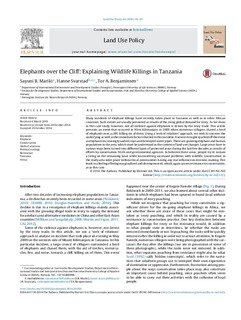Elephants over the Cliff: Explaining Wildlife Killings in Tanzania
Journal article, Peer reviewed

Permanent lenke
http://hdl.handle.net/11250/2393755Utgivelsesdato
2014Metadata
Vis full innførselSamlinger
- Publikasjoner fra CRIStin - NINA [2364]
- Scientific publications [1392]
Sammendrag
Many incidents of elephant killings have recently taken place in Tanzania as well as in other Africancountries. Such events are usually presented as results of the rising global demand for ivory. As we showin this case study, however, not all violence against elephants is driven by the ivory trade. This articlepresents an event that occurred in West Kilimanjaro in 2009 when numerous villagers chased a herdof elephants over a cliff, killing six of them. Using a ‘web of relations’ approach, we seek to uncover theunderlying as well as the immediate factors that led to this incident. A severe drought sparked off the eventas elephants increasingly raided crops and destroyed water pipes. There are growing elephant and humanpopulations in the area, which must be understood in the context of land use changes. Large areas have invarious ways been turned into different types of protected areas during the last few decades as results ofefforts by conservation NGOs and governmental agencies. In between these areas, people try to sustaina living on the remaining land, while encountering increased problems with wildlife. Conservation inthe study area takes place without local communities having any real influence on decision-making. Thisleads to a feeling of being marginalized and disempowered, which again causes resistance to conservation,as in this case.© 2014 The Authors. Published by Elsevier Ltd. This is an open access article under the CC BY-NC-NDlicense (http://creativecommons.org/licenses/by-nc-nd/3.0/).
